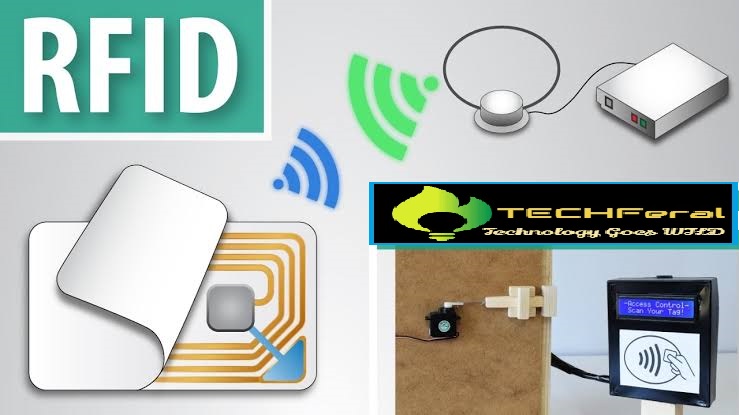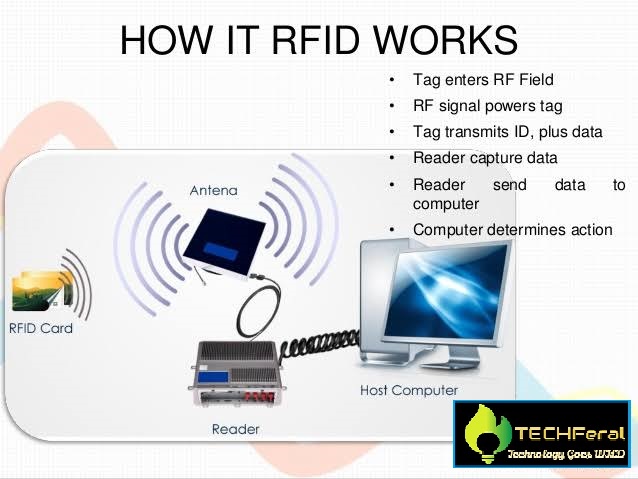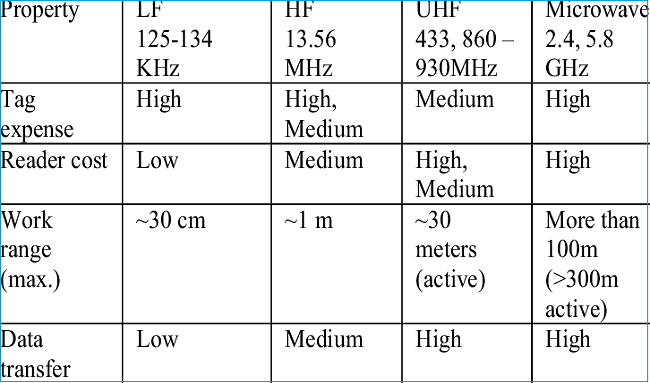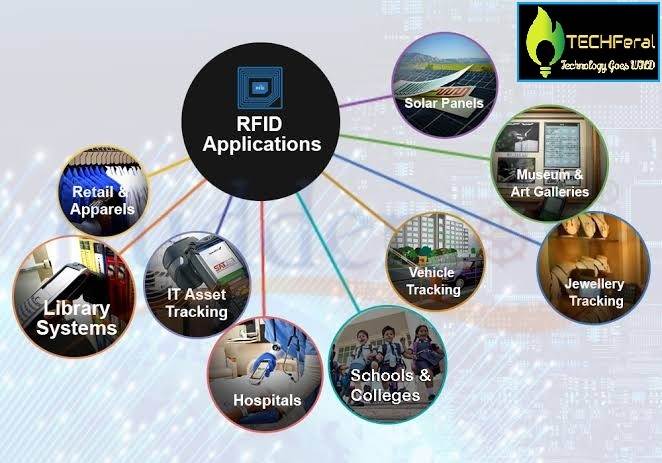
Last updated on : August 22nd, 2020 by Techferal
Welcome to a brief guide to the RFID world. This guide is ideal for beginners in RFID and who wants to learn about what technology is, how it is used, about the different types, and about the necessary labels and equipment.
RFID (radio frequency identification): RFID is a form of wireless communication that incorporates the use of electromagnetic or electrostatic coupling in the radio frequency portion of the electromagnetic spectrum to uniquely identify an object, animal or person. The practical day-to-day implementation of RFID technology includes medical care, manufacturing, inventory management, shipping, retail sales, and home use.

Radio Frequency Identification (RFID) is the wireless contactless use of radiofrequency EM waves to transfer data. Tagging items with RFID tags allows users to automatically identify and track inventory and assets automatically and exclusively. RFID takes automatic identification technology to the next level by allowing labels to be read without line of sight and, depending on the type of RFID, having a reading range of a few centimeters to more than 20 meters.

RFID has come a long way since its first aircraft identification application as friends or enemies in World War II. Technology not only continues to improve year after year, but the cost of implementing and using an RFID system continues to decrease, making RFID more profitable and efficient.
Under EM Spectrum, mainly three primary frequency ranges used for RFID transmissions and application – Low Frequency, High Frequency, and Ultra-High Frequency.

Low Frequency (LF):
High Frequency (HF):
Ultra-High Frequency (UHF):
Active RFID:
Passive RFID:
Primary Subsets of Passive RFID:
The relatively wide range of 860-960 MHz is recognized as the "Global Standard" for passive UHF RFID; however, its late adoption led to the range is further divided into two main subsets: 865-868 MHz and 902-928 MHz.
865 - 868 MHz - ETSI
The European Telecommunications Standards Institute (ETSI) is the governing body in Europe that establishes and maintains national standards for communication through multiple channels, including radio waves. According to ETSI regulations, RFID equipment and tags can only communicate in the smallest frequency range of 865-868 MHz because other types of radio communications are assigned to subsets of the largest range of 860-960 MHz.
Because ETSI sets the standards for Europe, but when buying labels and equipment, the standard can be called ETSI or EU denoting Europe.
902 - 928 MHz - FCC
The Federal Communications Commission (FCC) is the governing body in the United States that sets and maintains national standards for communicating through multiple channels, including Radio Waves. FCC regulations state that RFID tags and equipment can only operate between 902 and 928 MHz, because, like Europe, other types of communication are assigned to the remaining parts of the broadest range of 860 to 960 MHz.
RFID equipment or tags that are certified by the FCC or in the frequency range of North America, or NA, can be used throughout North America.
Other
Because both ETSI and FCC were the first important standards to be approved, many countries adopted one or the other, or created their own standards * within a subset of any of the frequency ranges. For example, Argentina chose to adopt the FCC range of 902-928 MHz, while Armenia chose to implement its own smaller band of 865.6-867.6 MHz within the ETSI range.
Although regional regulations such as FCC and ETSI are generally discussed using frequency ranges, there are other details that regulate each country, such as the amount of radiated energy (ERP or EIRP). Certain countries are more stringent and regulate where RFID can be used, the amount of "jump" frequency that must be used or that a license to use RFID is required. For more information on the regulations of each country, read "How to comply with regional regulations when RFID is used".
* Each region requires its own regional operating frequency, to find yours, click here.
The examples of applications that benefit from RFID are endless. Applications range from broad areas such as inventory tracking to supply chain management and may become more specialized depending on the company or industry. The types of RFID applications can range from IT asset tracking to textile tracking and even details such as rental item tracking.

What distinguishes a possible RFID application from applications that other types of systems can use is the need to uniquely identify individual elements quickly and more efficiently where traditional systems fall short. Below are some applications that successfully use RFID technology.
RFID Container Tracking System, File/document tracking, Race time, Follow-up of babies in hospitals, Animal tracking, Tracking tool, Jewelry tracking, Retail Inventory Tracking, Supply chain management, Pharmaceutical Tracking, Inventory tracking, IT Asset Tracking, Laundry and textile tracking, Tracking Returnable Transit Items (RTI), Event tracking and attendees, Access control, Vehicle tracking, Toll, Pipe, and reel tracking, Logistic tracking (materials management), DVD kiosks, Library materials tracking, Marketing campaign, Real-time location systems, etc.
An RFID system works on the principle of RFID technology. While each system will vary in terms of device types and complexity, each RFID system contains at least the following four components:
The simplest system may consist of a portable handheld RFID reader (with an integrated antenna) and RFID tags, while more complex systems are designed with multiport readers, GPIO boxes, additional functionality devices (e.g. battery lights ), multiple antennas and cables, RFID tags and complete software configuration.
What is an RFID tag?
An RFID tag in its most simplistic form consists of two parts: an antenna for transmitting and receiving signals, and an RFID chip (or integrated circuit, IC) that stores the tag identification and other information. RFID tags adhere to the elements to track them using an RFID reader and an antenna.
RFID tags transmit data on an element through radio waves to the antenna/reader combination. RFID tags usually have no battery (unless specified as active tags or BAP); instead, they receive energy from the radio waves generated by the reader. When the tag receives the reader/antenna transmission, the energy runs through the internal antenna to the tag chip. The energy activates the chip, which modulates the energy with the desired information, and then transmits a signal to the antenna/reader.
On each chip, there are four memory banks: EPC, TID, User and Reserved. Each of these memory banks contains information about the item that is tagged or the tag itself, depending on the bank and what has been specified.
Hundreds of different RFID tags are available in many shapes and sizes with features and options specific to certain environments, surface materials, and applications.
Because there is a wide variety of RFID applications, there is also a wide variety of RFID tags and ways to classify them. A common way to divide tags into types is inlays versus hard tags. The inlays are cheaper, usually ranging between $ 0.09 - $ 1.75 depending on the characteristics of the labels. Hard tags are generally more resistant and weather resistant and vary between $ 1.00 and $ 20.00.
Form factor: embedding, tag, card, badge, hard tag
Frequency type: LF, NFC, HF, passive UHF (902-928 MHz, 865-868 MHz or 865-960 MHz), BAP, active
Environmental factors: water-resistant, resistant, temperature resistant, chemical resistant
Customizable: shape, size, text, coding
Specific features/applications: laundry tags, sensor tags, embedded tags, autoclavable tags, vehicle tags, high memory tags
Specific surface materials: metal mounting labels, glass mounting labels, labels for liquid-filled items
Price of RFID tag:
The price of the label depends on the type of label and the quantity requested. As mentioned earlier, inlays generally vary between $ 0.09 - $ 1.75 and hard tags can vary between $ 1.00 - $ 20.00. The higher the level of customization or the more specialized the tag, the more expensive it will be compared to standard commercial tags.
Select an RFID tag
What type of surface will it label? In metal, plastic, wood, etc.?
What reading range do you want?
Size limitations (that is, the label cannot be larger than x by y by z inches)?
Any excessive environmental conditions to consider? Excess heat, cold, humidity, impact, etc.?
Method of attachment? Adhesive, epoxy, rivets/screws, flanges, etc.
The key to choosing a tag is the thorough testing of a variety of tags in your environment on the actual items you want to tag. Sample RFID tag packages can be customized for your application so you can reduce the appropriate tags for your application.
What is an RFID reader?
An RFID reader is the brain of the RFID system and is necessary for any system to work. Readers, also called interrogators, are devices that transmit and receive radio waves to communicate with RFID tags. RFID readers are generally divided into two distinct types: fixed RFID readers and mobile RFID readers. Fixed readers remain in one location and are usually mounted on walls, desks, portals or other stationary locations.
A common subset of fixed readers are integrated readers. An integrated RFID reader is a reader with a built-in antenna that generally includes an additional antenna port for the connection of an optional external antenna as well. Integrated readers are usually aesthetically pleasing and are designed to be used in indoor applications without high traffic of tagged items.
Mobile readers are handheld devices that allow flexibility when reading RFID tags while communicating with a host computer or smart device. There are two main categories of mobile RFID readers: readers with an on-board computer, called mobile computing devices, and readers that use a Bluetooth or auxiliary connection to a smart device or tablet, called Sleds.
Fixed RFID readers usually have external antenna ports that can be connected from an additional antenna to up to eight different antennas. With the addition of a multiplexer, some readers can connect to up to 32 RFID antennas. The number of antennas connected to a reader depends on the coverage area required for the RFID application. Some desktop applications, such as file input and output, only need a small coverage area, so an antenna works well. Other applications with a larger coverage area, such as a finish line in a career timing application, generally require multiple antennas to create the necessary coverage area.
The most common way to classify readers is to classify them as fixed or mobile. Other ways to differentiate between RFID readers include categories such as connectivity, available utilities, features, processing capabilities, power options, antenna ports, etc.
Frequency range: 902 - 928 MHz EE. UU., 865-868 MHz UE, etc. *
Mobility: fixed readers, integrated readers; Mobile readers
Connectivity options: Wi-Fi, Bluetooth, LAN, serial, USB, auxiliary port
Utilities available: HDMI, GPS, USB, camera, GPS, GPIO, 1D / 2D barcode, cellular capabilities
Processing capabilities: on-board processing, without on-board processing
Power options: power adapter, PoE, battery, in-vehicle, USB
Antenna ports available: no external ports, 1 port, 2 ports, 4 ports, 8 ports, 16 ports
What is an RFID antenna?
RFID antennas are necessary elements in an RFID system because they convert the RFID reader signal into RF waves that can be picked up by RFID tags. Without some type of RFID antenna, whether integrated or independent, the RFID reader cannot send and receive signals correctly to RFID tags.
Unlike RFID readers, RFID antennas are silly devices that receive their energy directly from the reader. When the energy of the reader is transmitted to the antenna, the antenna generates an RF field and, subsequently, an RF signal is transmitted to nearby tags. The efficiency of the antenna to generate waves in a specific direction is known as antenna gain. Simply put, the higher the gain, the more powerful and wider the RF field an antenna will have.
The RFID antenna emits RFID waves along a horizontal or vertical plane, which is described as the polarity of the antenna. If the RF field is a horizontal plane, is it described as horizontally linear, and the same principle applies to an RFID antenna that creates a vertical plane?
The polarity of an antenna can have a significant impact on the reading range of a system. The key to maximizing the reading range is to ensure that the polarity of an antenna aligns with the polarity of the RFID tag. If they do not match, for example, with a linearly polarized antenna and a label with a linearly polarized antenna, the reading range will be severely reduced.
A circularly polarized antenna transmits waves that rotate continuously between the horizontal and vertical planes to provide greater flexibility to the application by allowing RFID tags to be read in multiple orientations. However, because the energy is divided between two planes, the reading range of a circularly polarized antenna is shorter compared to a linear antenna of similar gain.
Types of antennas:
RFID antennas, like most RFID equipment, can be divided into different categories that help reduce the best antenna for an application. Although the antennas are grouped by some different factors, the most common clusters for RFID antennas are polarity (circular versus linear) and resistance (indoor vs. outdoor).
Through this post, it is clear that RFID based tracking facilitates an economic and accurate portable solution that is flexible, small and simple hardware.
If you have any query please feel free to comment in the comment box below. Also, please share the article with your friends and family.
Next Topic: Facial Recognition Technology
Hey there, You've done a fantastic job. I will certainly digg it and personally recommend to my friends.
I'm sure they'll be benefited from this site.
Yes! Finally someone writes about 더킹카지노.
Today, I went to the beach front with my children. I found a sea shell and gave
it to my 4 year old daughter and said "You can hear the ocean if you put this to your ear." She
put the shell to her ear and screamed. There was a hermit crab inside and it pinched her
ear. She never wants to go back! LoL I know this is entirely off topic but I
had to tell someone!